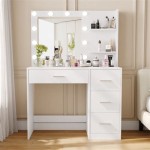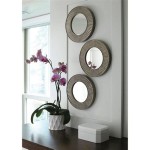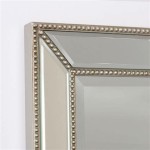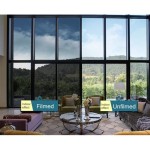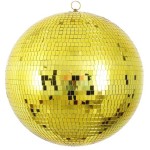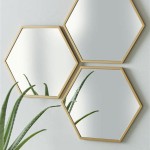Steam-Resistant Mirrors: A Clear View, Even in the Steamiest Conditions
Bathroom mirrors often fog up during hot showers, obscuring the reflection and creating a temporary inconvenience. Steam-resistant mirrors offer a practical solution to this common problem, providing a clear view even amidst the steam. This article explores the technology behind steam-resistant mirrors, their various types, installation methods, and key factors to consider when choosing one.
How Steam-Resistant Mirrors Work
Steam-resistant mirrors utilize a variety of methods to prevent fogging. The most common approach involves a thin, electrically conductive heating element applied to the back of the mirror. This heating element gently warms the mirror surface to a temperature slightly above the surrounding air, preventing condensation and maintaining a clear reflection.
Types of Steam-Resistant Mirrors
Several types of steam-resistant mirrors are available, each with its own characteristics and benefits:
* Heated Pad Mirrors: These mirrors feature a heating pad adhered to the back. The pad is typically connected to the bathroom lighting circuit, automatically activating when the lights are switched on. This is a cost-effective solution, but the heated area is limited to the pad's size. * Fully Heated Mirrors: These mirrors have a heating element covering the entire back surface, ensuring uniform heat distribution and eliminating fogging across the entire mirror. They offer superior performance but are generally more expensive. * Film-Heated Mirrors: A thin, transparent film containing the heating element is applied to the back of the mirror. This method provides even heating and maintains the mirror's aesthetic appeal. * LED Mirrors with Integrated Demister: These mirrors combine the functionality of LED lighting with a built-in demister, offering a sleek, modern solution with enhanced illumination and fog-free reflection.
Installation of Steam-Resistant Mirrors
Installation methods vary depending on the type of steam-resistant mirror:
* Hardwired Mirrors: These mirrors require a direct electrical connection and should be installed by a qualified electrician. They offer a more permanent and reliable solution. * Plug-in Mirrors: These mirrors come with a standard plug and can be easily installed by plugging them into a nearby outlet. They offer greater flexibility in terms of placement. * 12V Mirrors: These mirrors operate on a lower voltage and are typically connected to a transformer. They are often easier to install than hardwired options.
Choosing the Right Steam-Resistant Mirror
Several factors should be considered when selecting a steam-resistant mirror:
* Size and Shape: Steam-resistant mirrors are available in various sizes and shapes to suit different bathroom layouts and design preferences. * Heating Element Type: Consider the size and placement of the heating element based on the desired level of fog-free coverage. * Power Consumption: While energy consumption is generally low, comparing wattage can help identify more energy-efficient options. * Additional Features: Some steam-resistant mirrors offer additional features like built-in lighting, Bluetooth connectivity, and magnification options. Analyze these features according to your specific requirements and budget. * Budget: Steam-resistant mirrors vary in price according to their features, size, and technology. * Warranty: Check for warranty information as it provides assurance of the product’s quality and durability.
Benefits of Steam-Resistant Mirrors
Steam-resistant mirrors offer a range of advantages:
* Clear Reflection: The primary benefit is a consistently clear reflection, even during and after hot showers. * Enhanced Safety: A clear mirror improves visibility, reducing the risk of accidents in a potentially slippery bathroom environment. * Convenience: Eliminates the need to manually wipe down the mirror after each shower. * Improved Aesthetics: Contributes to a more modern and upscale bathroom design.
Maintaining Steam-Resistant Mirrors
Proper maintenance ensures optimal performance and longevity:
* Cleaning: Use a soft, damp cloth and a mild glass cleaner. Avoid abrasive cleaners that could damage the mirror surface or the heating element. * Power Supply: For hardwired mirrors, ensure the electrical connection is secure and functioning correctly. For plug-in mirrors, avoid overloading the electrical circuit. * Inspection: Regularly inspect the mirror and its heating element for any signs of damage or malfunctioning.
Integrating Steam-Resistant Mirrors into Bathroom Design
Steam-resistant mirrors can be seamlessly integrated into various bathroom design styles:
* Modern Bathrooms: Sleek, frameless steam-resistant mirrors complement minimalist and contemporary aesthetics. * Traditional Bathrooms: Framed steam-resistant mirrors can be incorporated into more traditional bathroom designs. * Small Bathrooms: Strategically placed steam-resistant mirrors create the illusion of greater space while offering practical functionality in compact bathrooms.

Steam Proof Mirror Bathroom Lighted

Heated Bathroom Mirrors Demister Mirror Drench

Bathroom Wall Mirror Cabinet With Led Lights Clock 220v Socket Steam Resistant

Vivitar Led Lighted Steam Resistant Vanity Mirror 1 Unit Foods Co

Vivitar Led Lighted Steam Resistant Vanity Mirror 1 Unit Foods Co

Vivitar Led Lighted Steam Resistant Vanity Mirror Com

Bathroom Wall Mirror Cabinet With Led Lights Clock 220v Socket Steam Resistant

Vivitar Led Lighted Steam Resistant Vanity Mirror Com

Vivitar Led Lighted Steam Resistant Vanity Mirror 1 Unit Foods Co

Bathroom Wall Mirror Cabinet With Led Lights Clock 220v Socket Steam Resistant

